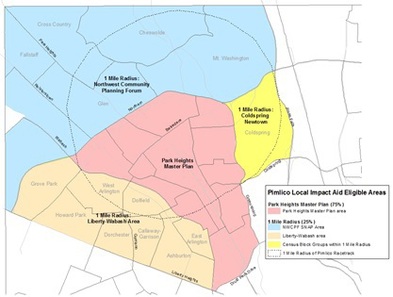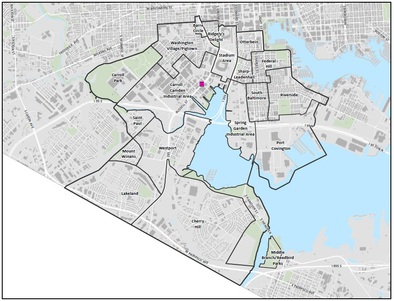|
Local Impact Aid Update
Maryland’s legislation
authorizing casino gaming mandates that 5.5% of statewide revenues from
electronic slot machines, referred to as “video lottery terminals,” or VLT’s, fund
Local Impact Aid, with 82% allocated to the local government jurisdiction for
infrastructure improvements, public safety, sanitation, and economic and
community development in areas surrounding the VLT facility. The remaining 18% of
VLT revenues from the Baltimore, Anne Arundel, and future Prince George’s
County casinos supports community and economic development activities in a
defined area surrounding Pimlico Race Course.
Pimlico Local Impact Aid
In the Pimlico area, $4.5 million in Local Impact Aid is projected for
FY’16, with 75% allocated to implementing the Park
Heights Master Plan and the remaining 25% for other neighborhoods within a roughly
one-mile radius of the Race Course (see Map).
 Above: Map of Pimlico Local Impact Aid Eligible Areas
In Park Heights, funds are
focused on continued acquisition, demolition and preparing for future uses
within the “Major Redevelopment Area” described in the Master Plan. Funds are
also supporting human service and public health programs for community youth
and their families. In the wider area,
priorities include improving park facilities, addressing residential vacancy
and strengthening local community associations. The draft
FY’16 Spending Plan and other key documents can be found on the PCDA’s website. The PCDA is accepting public comments
on the spending plan through November 14, 2014 to inform its recommendations to
the Administration.
Casino Local Impact Aid
The Baltimore Casino Local Impact Area encompasses the neighborhoods of Barre
Circle, Cherry Hill, Federal Hill, Lakeland, Mount Winans, Otterbien,
Pigtown/Washington Village, Sharp-Leadenhall, Ridgley’s Delight, Saint Paul,
South Baltimore and Westport, plus the sports stadiums and the Carroll-Camden,
Port Covington and Spring Garden industrial areas (see Map).
 Above: Neighborhoods within the Baltimore Casino Local Impact Area
The FY’15 Spending Plan for Casino Impact Funds allocated $7
million for community priorities, such as workforce development, streetscape
enhancements and increased sanitation in the neighborhoods, and for
infrastructure improvements, policing and other services in the blocks
immediately surrounding the Horseshoe Casino. The Draft FY’16 Spending Plan recommends
allocating revenues, anticipated between $9-12.5 million, to projects that
include “complete streets” upgrades, youth employment opportunities and small
business assistance, among other priorities identified by the LDC. The LDC began its
45-day review of the City’s recommended FY’16 spending on October 30, 2014.
Documents related to the FY’15 and ’16 Spending Plans and information regarding
meetings can be found on the LDC’s
website. (For further information, contact Project Coordinator Ethan Cohen
at 410-545-3107 or ethan.cohen@baltimorecity.gov).
The Department of Planning is
working with the LDC to finalize a Master Plan for the Casino Impact Area by
early 2015. The South
Baltimore Gateway Master Plan will articulate goals, strategies and
recommendations developed with input from community stakeholders and City
agencies through a process that began in 2013, and will provide the guideposts
for spending Local Impact Aid in future years. |